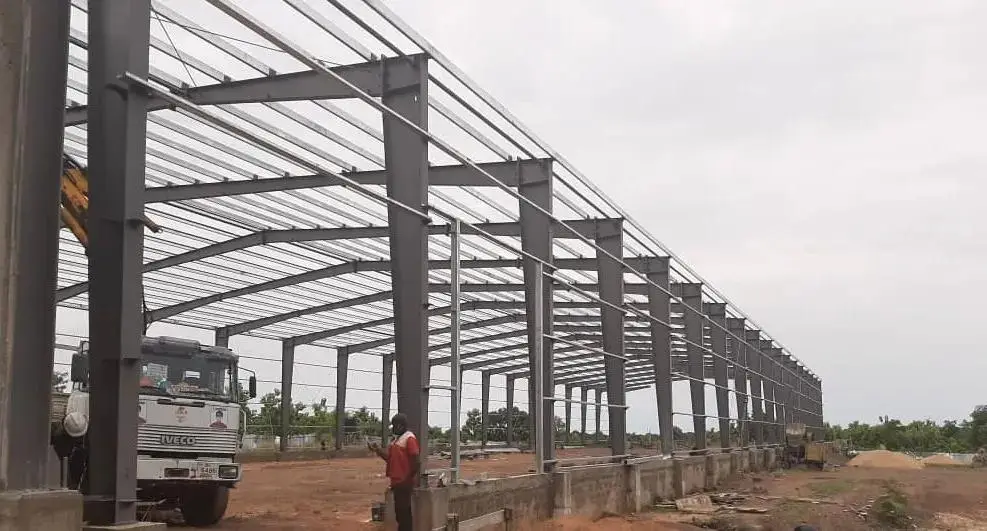Tel: 0086-532-88966982
0086-532-88965892
Website: www.lidajituan.com
E-mail: sales@lidajituan.com
Head office: 5th Floor, Building A, Dalen Center, 180 Haier Road, Qingdao, 266000, China
Sustainable Steel Constructions: Eco-Friendly Solutions for Factories and Warehouses
Classification:Industry News
Release time:2025-04-25 17:00
Sustainable Steel Constructions: Eco-Friendly Solutions for Factories and Warehouses
As industries face mounting pressure to reduce carbon footprints, steel structures—particularly light steel structures—are emerging as the cornerstone of eco-friendly constructions. From steel warehouses to manufacturing workshops, suppliers like Lida Group are revolutionizing green buildings through recycled materials, energy-efficient designs, and circular economy principles. This article explores actionable strategies for contractors and developers to achieve sustainability goals without compromising functionality.
Why Steel is the Sustainable Choice for Industrial Buildings
Environmental Impact Comparison
Steel outperforms traditional materials due to:
- High recyclability: 90% of Lida Group’s light steel structures use recycled scrap steel.
- Lower embodied carbon: Advanced production methods reduce emissions by 50% since 1990.
- Adaptive reuse: Steel frames can be disassembled and repurposed, minimizing demolition waste.
5 Key Strategies for Sustainable Steel Constructions
1. Recycled and Low-Carbon Steel Grades
Opt for suppliers certified by the ResponsibleSteel initiative, like Lida Group, who prioritize:
- Q235B/Q345B steel: Made from 85-95% recycled content, reducing virgin resource extraction.
- Electric Arc Furnace (EAF) production: Cuts CO2 emissions by 75% vs. blast furnace methods.
Case Study: A 2023 Lida Group steel warehouse in Sweden achieved net-zero embodied carbon using 100% recycled steel and carbon offset programs.
2. Energy-Efficient Design Innovations
Modern steel workshops integrate passive and active energy solutions:
A. Insulated Panels and Cool Roofs
- PU sandwich panels: U-value of 0.22 W/m²K, reducing HVAC loads by 35%.
- Solar-reflective coatings: Lower roof temps by 15°C, cutting cooling costs in steel warehouses.
B. Renewable Energy Integration
- Solar-ready roofs: Lida Group’s designs support 25-40 kW solar arrays per 10,000 sq.ft.
- Wind-resistant designs: Aerodynamic shapes optimize rooftop turbine efficiency.
3. Prefabrication and Waste Reduction
Light steel structures built off-site slash resource waste:
- Precision engineering: CNC cutting reduces steel scrap by 30% vs. on-site builds.
- Modular designs: Lida Group’s bolt-together systems allow 95% material reuse in expansions.
Waste Comparison:
- Traditional construction: 145 kg/m² waste.
- Prefab steel construction: 22 kg/m² waste.
4. Green Certifications and Compliance
Sustainable buildings gain market value through certifications:
- LEED Platinum: Lida Group’s steel warehouses earn 12+ points for recycled materials and energy modeling.
- BREEAM Outstanding: Achieved by optimizing daylighting in workshop constructions.
- Living Building Challenge: Net-positive energy/water designs for factories.
5. Circular Economy Partnerships
Collaborate with suppliers and contractors committed to closed-loop systems:
- Take-back programs: Lida Group reclaims 80% of demoed steel for reprocessing.
- Local sourcing: Regional steel mills cut transport emissions by 60%.

Lida Group’s Pioneering Sustainable Projects
Net-Zero Automotive Workshop in Germany
- Structure: 100% recycled light steel structure with EPDM roofing.
- Energy: Geothermal heating + 560 solar panels covering 120% of energy needs.
- Result: 62% lower operating costs vs. conventional builds, with carbon neutrality achieved in 2023.
Zero-Waste Steel Warehouse in Singapore
- Innovation: AI-powered material tracking ensured 99% construction waste diversion.
- Design: Modular mezzanines adaptable to future tenant needs.
How Contractors Can Maximize Sustainability
- Specify low-embodied carbon steel: Require mill certificates with EPDs (Environmental Product Declarations).
- Adopt BIM clash detection: Reduce rework (and waste) by 18%, as proven in Lida Group’s workflows.
- Train crews on circular practices: 70% of construction emissions stem from on-site practices.
Future Trends in Green Steel Constructions
- Hydrogen-reduced steel: Pilots by 2026 could cut emissions by 95%.
- Bio-based coatings: Soybean oil alternatives to chemical sealants (tested by Lida Group in 2024).
- Carbon capture factories: Integrated into steel plants by 2030.
Conclusion: Building a Greener Future with Steel
Sustainable steel structures are no longer optional—they’re a competitive advantage. By partnering with visionary suppliers like Lida Group, developers can construct steel warehouses and workshops that slash emissions, cut lifecycle costs, and meet tightening global ESG mandates. The data proves it: steel is the smart choice for factories and warehouses where ecology meets economy.

light steel structure,modular house,contractores,constructions
Contact Us
Head Office: 5th Floor,Building A,Darron Center,No.180,Haier Road,Qingdao, 266000,China
Tel: 0086-532-88966982 88965892 Fax:0086-532-88965571
WhatsApp:+86 13793209022
Mobile/Wechat:+86-15166671720
Email: sales@lidajituan.com Website: www.lidajituan.com
Alternate Website: www.lidamodularhouse.com
Head Office: 5th Floor,Building A,Darron Center,No.180,Haier
Road,Qingdao, 266000,China
Tel: 0086-532-88966982 88965892
Fax:0086-532-88965571
Email: sales@lidajituan.com
Website: www.lidajituan.com
Alternate Websit: www.prefabhousecn.com
Wechat/WhatsApp:+86-13793209022
Copyright(c)2023 All Rights Reserved SEO Business license

